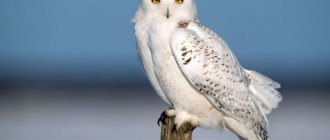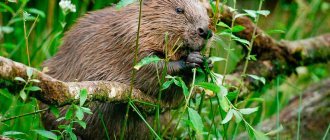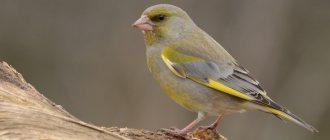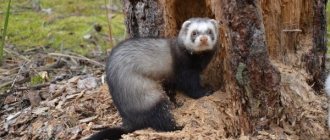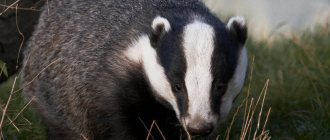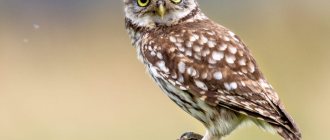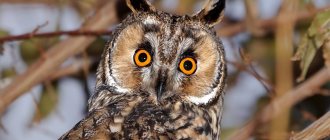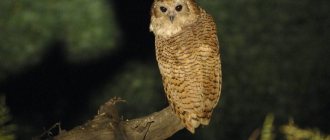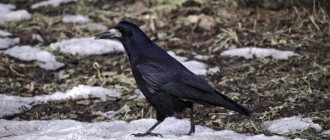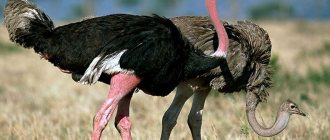Appearance
The body length of a polar owl can reach up to 65 centimeters, and the bird weighs no more than three kilograms. Males are smaller than females. The bird's plumage is soft and fluffy, thanks to which it can live in the local climate of northern latitudes. The owl's round head with bright yellow eyes is noteworthy. The white plumage of the bird may have brown longitudinal stripes. As a rule, females show off these stripes. In males they may be completely absent. The owl's beak and ears are hidden under feathers. Polar owls are endowed with distinctive hearing and acute vision, which helps these individuals hunt even in the pitch darkness of the polar night.
The voice of a polar owl
What type of bird is it and what is it called?
It is also known as the white owl. Belongs to the genus Owls, the Owl family and the class Owls. The bird got its second name because of the white color of its feathers. At first it was separated into a separate genus. However, modern ornithologists attribute it to the genus Owl.
The polar owl looks very interesting
Important! Scientists believe that its ancestor lived about 80 million years ago. This fact is confirmed by the fact that polar owls are found on all continents. But they do not fly across the ocean on their own.
The main difference between owls and other birds is the absence of eyeballs. This is the reason why their eyes do not move. This feature is compensated by the mobility of the neck: it can rotate 240°. Owls also have very sharp eyesight.
Adult bird
Nutrition
The main food of snowy owls is traditionally lemmings. This type of rodent is widespread in the range of polar owls. To satisfy its hunger, a snowy owl needs to eat more than four lemmings per day. In addition to these rodents, birds like to hunt larger mammals. Their best prey is hares and cubs of arctic foxes or stoats. It doesn’t mind eating other birds, fish and even carrion.
The polar owl does not hunt near its habitat so as not to attract predators to it. Thanks to this, seagulls build their nests next to the bird, as they can feel safe there.
Features of character and lifestyle
These birds try to settle as far as possible from humans. Therefore, rarely anyone gets to see her. The polar owl has an independent character - almost all individuals prefer to live alone. Individuals form pairs only during the breeding season.
Owls communicate with each other, and with their loud and harsh sound they are able to scare away enemies. But these are not chatty birds: they communicate with each other only during the breeding season. During other periods, they devote most of their time to sleeping or hunting.
For reference! The main distinguishing feature of this species is the ability to lead a diurnal lifestyle. Other species of owls hunt exclusively at night.
These birds hunt mainly for rodents. Thus, they regulate their numbers, which has a positive effect on the state of the ecosystem of the tundra zone. Although snowy owls do not hunt near their nests, they defend their territories. This is used by other birds, such as seagulls. Therefore, they settle near owl nests.
Owl with white plumage
Reproduction
The breeding season of polar owls marks the arrival of spring. It is in the spring that birds return from wintering grounds, look for a suitable place and announce their choice with loud cries. If the female responds, then the male begins to put on a whole show in front of her: he brings prey, shows his wings, makes demonstrative flights and accompanies his chosen one all day.
The resulting couples remain together for a long period. They participate together in the education process.
The female begins laying eggs in early May. As a rule, she is able to lay no more than eight eggs per day. The incubation process lasts up to one month, after which the eggs begin to hatch. Not all owlets are born at the same time. Quite often, late babies do not survive. After all the cubs are born, the female and the male fly out in search of food. At this time, small polar owls huddle alone in their nests.
The owlets become capable after a month and a half of life.
Snowy owl chick
Hunting
Long-eared owls hunt in different ways. The type of hunting is determined by the biotype of habitat and its noise level. As a rule, most long-eared owls choose mixed forests as habitats. When hunting in the forest, the long-eared owl tracks its prey on high tree branches and waits for the prey to be distracted so that it can quickly attack it. Living in open areas, long-eared owls use search flight. The bird circles above the ground in search of potential prey. Some long-eared owls guard their food by sitting on the ground.
Lifestyle
Polar owls are active during the day, but go out to search for prey either early in the morning or late in the evening. Thanks to its abilities, the bird is an excellent hunter at any time of the day. When there is insufficient food, polar owls fly closer to populated areas.
They usually wander from September and return at the beginning of October. Many birds remain in place, provided there is sufficient food.
Some individuals can lead a solitary lifestyle without forming pairs.
How does the polar queen live?
Owls prefer open space. It is very rare to see it in sparse tundra forests. They obtain food in the steppes and can sometimes appear near human habitation.
September-October is nomadic time for birds. They move to the southern regions of the tundra and live there until April. In some places, the polar owl remains to winter in place, but this should be an area free of Arctic ice and not very snow-covered.
No matter how unpretentious the white beauty is to food, sometimes she needs to eat too. Hunting is a separate topic for discussion about the polar owl. And here it would not be amiss to remember that the owl is a predator, and its methods, to put it mildly, are slightly at odds with the royal noble appearance.
The hunting habits of birds are divided into two types. She can either watch over her prey, sitting on a hill, frozen, waiting for the victim to “fall” into her claws. This method is preferable, because the bird always tries to conserve as much energy as possible. Or, more often in the evening or early in the morning, the owl pursues prey in flight. And you can rest assured that the “dish” chosen on the menu has no chance.
Once caught in the strong claws of a predator, the small prey is swallowed immediately. But the big one was less fortunate. The owl takes it to the nesting site, tears it into small pieces, often while still alive, and only then eats it. This is such bloodthirsty, “unroyal” behavior.
Enemies in the wild
The main enemies of polar owls in the tundra are arctic foxes. In search of easy prey, arctic foxes often steal small owls from the nest. In addition to arctic foxes, white owls should be wary of foxes, which are also not averse to feasting on their fragile chicks.
When a person approaches their territory, polar owls emit loud, frightening calls. Sometimes, when danger approaches, they hover over their potential enemy to assess further actions. When directly attacking a nest, the males engage in combat with the destroyer, making loud sounds similar to the cawing of a crow.
Sounds of owls and silent flight
Owls are quite emotional creatures. By the sounds they make, you can completely unmistakably guess the state of the bird at one time or another. Snowy owls can whistle, hiss, croak, bark and screech loudly. For example, during the mating season, the male makes dull barking sounds, to which the female responds with even lower ones. The voice of the male, alarmed by the approach of a stranger to the nest, becomes dull and abrupt.
Owls fly silently: a special crest of hard feathers located along the leading edge of the wing, a fringe of soft feathers covering the rear edge of the wing, and special down on the wing on top act like a soft carpet: thanks to this coating, air flows very gently and almost silently around the wing . The wingspan is 150-160 cm. Studying the flight of owls has made scientists think about creating artificial materials from which it will later be possible to build silent vehicles.
Habitat
The polar owl can be found in the northern latitudes of both hemispheres. Individuals of polar owls are widely distributed throughout the Arctic Ocean. In particular, they live on Wrangel Island, New Zealand, Greenland and Spitsbergen.
Snowy owls prefer to inhabit large open areas and small mountain hills. As a rule, they avoid wooded areas, sticking to tundra and forest-tundra. This is due to the fact that in deep forests it is much more difficult for owls to find prey.
In culture
The polar owl is depicted on the coat of arms of the city of Novy Urengoy, Yamalo-Nenets Autonomous Okrug.
The polar owl is the official symbol of the province of Quebec (Canada).
The polar owl is depicted on the coat of arms of Kayerkan (now a district of Norilsk).
In the Harry Potter series of novels (later the film series), there is a white owl named Hedwig (Hedwig). This bird belonged to Harry Potter and was able to deliver letters and parcels.
In the full-length cartoon "Penguins of Madagascar" there is the character of the snowy owl Eva.
The name “Polar Owl” is given to one of the correctional colonies for life-sentenced prisoners in Russia.
Hawk owl
Hawk owl
(lat.
Surnia ulula
) - a medium-sized long-tailed owl. Order: Owls. Class: Birds. Type: Chordata. Kingdom: Animals.
Description.
Externally, the bird is similar to an owl and a sparrowhawk, which is why it received such a name. Her body is dense, her head is large, the facial disc is not very well defined, the tail is long, stepped, the wings are short and wide, the color of the lower body is like that of a hawk. The flight is similar to that of a hawk: the bird makes a series of wing beats and then glides on outstretched wings. When hunting, the hawk owl hovers in the sky like a kestrel. When sitting on the top of a tree or pole, the bird does not sit upright like owls, but leans forward like a hawk.
Chocolate-brown above with white spots, almost white below with sharp thin transverse stripes. The eyes and beak are yellow, there are no “ears”. The flight is fast, straight, usually low above the ground. Length - 35-43 cm. Wingspan 60-80 cm.
Voice. The spring song of the male is not often heard. This is a sonorous, fast trill - “prullulululla...” with a length of 3-6 seconds, sometimes up to 10. When alarmed at the nest, the male and female emit a quick trill of abrupt, hoarse sounds: “ki-ki-ki-ki-kip” and a series of hoarse cries “kip-kip-kip...” (https://onbird.ru/opredelitel-ptic/yastrebinaya-sova/golos).
Lifestyle.
The nest can be located on old stumps, in half-hollows, less often in hollows or old nests of crows or other birds of prey. Nests were also found on the ground. There are 3-9, occasionally up to 13 white eggs in a clutch. The female incubates for about 25 days. The chicks sit in the nest for approximately the same amount of time, after which they move to the branches of neighboring trees. The chicks are fed by both parents. The parents actively defend the nest, boldly attacking the person, trying to hit them on the head with their claws.
The most common prey species are voles, lemmings and mice. If they are deficient, they can catch squirrels and small birds, and sometimes successfully attack hazel grouse, ptarmigan and even black grouse. They are active mainly at dusk, but also hunt during the day.
Habitats.
Prefers open coniferous forests, or mixed with larches, birches, poplars and willows. Hawk owls also live in peat bogs, meadows, clearings, and burnt areas.
Area. They live p
mainly in the forests of Eurasia and North America. Sedentary or nomadic bird. In Russia it is found on the coast of the Sea of Okhotsk, in Kamchatka, in the Magadan region, in Chukotka, as well as from the south of Altai to the southern Transbaikalia and Primorye. Isolated areas of the range exist in the Tien Shan.
Security status.
Listed in the Red Book of the Tver Region. Since 1978 it has been under special protection in the Moscow region.
Interesting Facts.
The asteroid (714) Ulula, discovered in 1911, is named after the hawk owl.
Used sources:
https://web-zoopark.ru/ptitsi/yastrebinaya_sova.html
https://ru.wikipedia.org/wiki/Hawk_owl
https://o-prirode.ru/jastrebinaja-sova/
What does it eat?
In terms of their feeding habits, wading birds are classified as predators. They go hunting in the evening and at night, but there are also daytime hunters who like to look for food. For example, owl chicks can often be seen during the day while hunting for small mammals.
The main food for birds are mice and other rodents. In the steppe, owls catch jerboas and hamsters. Short-eared owls eat insects and birds rarely and at times when there is no main prey. Hunting usually takes place in low flight. The attack occurs from above, then the prey is carried in the talons to the owl's nest.
During the hunt, you can observe the dexterity and cunning of a short-eared owl that goes hunting.
Where does it live?
The owl is called the ruler of the forest. Its typical habitat is coniferous or mixed forest, forest-tundra, taiga thickets. Often nests in swamps, tall pines, spruces, and burnt areas. It can also be found near people's homes.
The habitat of this species is Eurasia, North America. In the Russian Federation - from the Altai expanses to Primorye, harsh Magadan, Kamchatka, Chukotka Autonomous Okrug, the coastal zone of the Sea of Okhotsk. Small numbers of families are found in the high Tien Shan.
What does it look like
The hawk owl resembles a sparrowhawk in appearance.
She has the following signs:
- Large head size with ears without feathers.
- Round, yellowish eyes.
- Compact, strong torso.
- Short wing, long tail with cascading plumage.
- Grayish-brown coloring with a bluish tint.
- Gray-white covering of the facial disc.
- A clear striped pattern on the bottom of the body.
A flying owl is often confused with a hawk - due to the similar flapping of its wings and silent gliding.
| Scientific classification | |
| Domain | Eukaryotes |
| Kingdom | Animals |
| Sub-kingdom | Eumetazoans |
| No rank | Bilaterally symmetrical |
| No rank | Deuterostomes |
| Type | Chordata |
| Subtype | Vertebrates |
| Infratype | Ghostostomes |
| Superclass | Quadrupeds |
| Treasure | Amniotes |
| Class | Birds |
| Subclass | fantail birds |
| Infraclass | New palates |
| Treasure | Neoaves |
| Squad | Owls |
| Family | Owls |
| Subfamily | Surniinae |
| Genus | Hawk owls |
| View | Hawk owl |
| International scientific name | Surnia ulula |
| Security status | Least Concern |
Wintering
There are no designated areas for winter nesting. In the cold season, owls usually settle near the boundaries of their range, which are located south of their permanent nesting sites. Of course, some birds migrate from the northern regions to the southwest.
Many individuals winter near taiga clearings, some fly to forest-steppe areas. Mostly, the winter period for feathered predators takes place where there are open landscapes: cleared plots, river floodplains, burnt areas, fields. Lately they have taken a fancy to populated areas.
Short-eared Owl in the Red Book
The danger for the short-eared owl is agricultural work in the fields. When machinery is used, grass is burned or livestock is grazed. All this threatens the bird's chicks. We should not forget that there are hunters who can shoot rare birds.
Current population situation
The total population of the short-eared owl is not known exactly; it is approximately 850 – 1,700 pairs. Beginning in 1960, bird numbers began to decline sharply. In years when there is an increase in rodents, the number of Red Book representatives is stable.
The population of short-eared owls is threatened by various diseases, for example, tuberculosis. We should not forget about accidents when birds are hit by cars and planes.
An important role in the population of this species of owls is played by the destruction of their usual habitat, namely the drainage of swamps, sowing of all free plots of land in fields, etc.
What measures were taken to protect
Short-eared owls, along with other species of endangered birds, are protected in nature reserves and national parks. This type of owl is protected by the Berne Convention and is included in the list of animals in need of strict protection. It is also prohibited to trade wading birds in order to preserve the population and the possibility of their complete extinction.
Where does the snowy owl spend the winter?
Taking off, they heavily flap their wings, sometimes fluttering them in one place, holding the victim grabbed by their clawed paws. For the winter, depending on the availability of food, owls either remain in the tundra or migrate (usually in October) south to the forest and steppe zones of Russia, reaching the border of the deserts.
Interesting materials:
How to cook reindeer horn mushrooms? How do fold-eared cats behave? How to return boots to their original appearance? How to return the clock to the Samsung desktop? How to return a day back in Sims 4? How to return Yandex station? How to reset Nokia Lumia to factory settings? How to bring a corrector back to life? How to return the mouse cursor to the screen? How to return the menu to the right in Photoshop?
